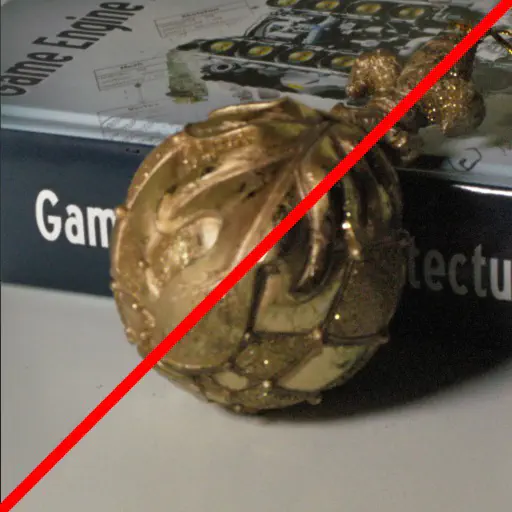
Abstract
abstract
AbstractIn the real world, materials often show both diffuse and specular reflections. To separate these two reflection components may help applications which need consistent object surface appearance. In fact, many algorithms used in numerous tasks of computer vision, computer graphics and image processing, work under the assumption of perfect Lambertian surfaces (or perfect diffuse reflection). They consider specular pixels (or highlights) as outliers or noise. Moreover, the two reflection components can be processed separately and afterwards recombined to produce particular visual effects [MZK*06] (dichromatic editing Figure.1).
Figure 2: Example of an image where the presence of highlights generates the loss of details and colour information. Details and colours are completely washed out in the highlights region.
Several specularity removal techniques are available in literature; they differ in the information they use and in how it is used. Table 1 summarises how these techniques may be classified and in which paragraph of this survey they are explained. The notation used in Table 1 for the categories is the following: CSA, colour space analysis; NA, neighbourhood analysis; POL, polarization; IS, image sequences; MFI, multiple-flash images. The notation used in Table 1 for the techniques is the following: CRM, using colour reflection model [KSK87, KSK88]; TDA, 2D diagram approach [ST95b, SK00]; BM, Bajcsy et al. method [BLL96]; USFI, use of specular-free images [TI05b, YCK06, SC09]; PDE, PDE approach [MZK06]; IT, in-panting technique [TLQ06]; CC, use of colour information and classifier [TFA05]; TS, separation of highlight reflections on textured surfaces [TLQ06]; FR, Fresnel methods [Ang07]; HM, histogram methods [CGS06]; HFLF, high-low frequency separation [LPD07, NGR06]; MBS, multi-baseline-stereo [LB92, LYK03, LS01]; MII, deriving intrinsic images from image sequences with illumination changes [Wei01]; CP, colour and polarisation methods [NFB97, KLHS02, MPC*07, USGG04]; MF, multi-flash methods [FRTT04, ARNL05].
Table 1: The classification of highlights removal methods. These methods are classified based on the number of image used as input an the type of information used. L and G respectively stand for global and local approach. The number, in the first column, indicates the paragraph in the paper where the technique appears in the survey.
Single Image Multiple Images
Tech. - Sec. Type CSA NA IS MFI POL
CRM - 3.1.1 G x
TDA - 3.1.2 L x
BM - 3.1.3 G x
USFI - 3.2.1 L
- x
PDE - 3.2.2 L - x
IT - 3.2.3 L - x
TS - 3.2.4 L - x
CC - 3.2.5 L - x
FR - 3.2.6 G
- x
HM - 4 G
- x
HFLF - 4 G - - x
MBS - 4.1 G - - x
MII - 4.2 L
- x
CP - 4.3 G
x
MF - 4.4 L
- x
Discussion Several factors may influence which approach is superior to another one, such as the number of images to be captured, automatic operation vs. manual help, light constraints and the reflectance model used, merits of quality, and the hardware used during the acquisition phase. Table 2 provides a comparative summary of the specular removal methods discussed in this survey.
Table 2: Comparison of the highlight removal techniques by their characteristics. The methods are grouped into the single-image category (top) and the multiple-image category (bottom). User Interaction: MS manual segmentation, A automatic, NS no segmentation, Light Requirement: IC illuminant compensation, DM dichromatic reflectance model, and FM flash model. Hardware: S single camera, M multiple camera, * polarised filters, FS flash system
Technique Images User Interaction Light Requirement Hardware
Colour Space [KSK87, KSK88, ST95b, SK00, BLL96] 1 MS IC-DM S
Specular-Free Image [TI05b, YCK06, SC09] 1 A IC-DM S
Inpainting [TLQ06] 1 MS IC-DM S
PDE [MZK*06] 1
IC-DM S
Textured Surfaces [TLQ06] 1 MS IC-DM S
Colour Classifier [TFA05] 1
S
Fresnel Coefficient [Ang07] 1 MS No IC-DM S
Multi-Baseline Stereo [LB92, LYK*03, LS01] 50-70 NS DM M
Deriving Intrinsic Images [Wei01] 40-70 NS Lighting changes S
Polarization [NFB97, KLHS02, MPC07, USGG04] 6-10 NS DM S
Histogram [CGS06] 200 NS - S
High-Low Frequency Separation [LPD07, NGR06] 4, 32 NS
S
Multi-flash [FRTT04, ARNL05] 4-8,2 NS FM FS
Finally we have performed several experiment, to compare different specularity removal techniques, on various input images starting from single-colour, multi-colour and textured surfaces, increasing the texture complexity.
ReferencesFor the references please see the paper.